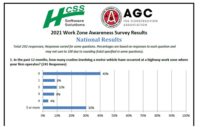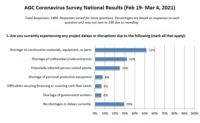Contractors have a mixed outlook for 2024 according to a forecast report released by the Associated General Contractors of America and Sage Construction and Real Estate.
Changes in demand for projects and how to adopt new technologies such as artificial intelligence are the biggest questions facing contractors according to survey results of 1,293 AGC contractor-members, released by the AGC and Sage January 4.
AGC CEO Stephen Sandherr said contractors are struggling to cope with significant labor shortages, the impacts of higher interest rates and input costs, and a supply chain that, while better than it has been since the outset of the global COVID-19 pandemic, is still far from normal.
"Demand for different types of projects is changing," he said. "Respondents to this year's outlook survey are less confident about growth prospects for many market segments than they were just a year ago. They are most optimistic about a range of public sector market segments including water and sewer projects, transportation, federal projects and bridge and highway. Conversely, they predict private sector demand will be less robust for segments like manufacturing, multifamily residential, and will also decline for lodging, retail and private office construction."
The percentage of respondents who expect the available dollar value of their projects to increase, compared to the percentage who expect it to shrink, is positive for 14 of the 17 project categories in the survey, as it was in 2023. However, AGC notes that a smaller share than last year expects the markets they compete in to expand in the coming year. The net reading decreased from the 2023 survey for nine project types, increased for six types, and remained unchanged for two.
The highest net positive reading in the 2024 survey, at 32%, was for water and sewer construction. Sandherr said most contractors surveyed continue to see projects being delayed sometimes indefinitely because of rising costs, slower schedules and shrinking demand. Perhaps because of these challenges, he said, contractors plan to invest in new technologies that promise to make their operations more efficient and productive. Many firms reported they will make new or continued investments in drones, artificial intelligence tools and offsite production of project components.
"The largest increase in optimism from the previous survey is for data center construction with a net positive reading of 20%. That's up from 12% a year ago. And I think it reflects all the enthusiasm about a generator of artificial intelligence, AI, which is a huge user of data center capacity," said Ken Simonson, chief economist at the AGC.
Federal Funding Reaches Public Projects
Angie McElhaney, chief financial officer of Mark One Construction in Kansas City, Mo., said on AGC's conference call that federal money was flowing from the 2021 Infrastructure Investment and Jobs Act and other federal measures, including $2.8 billion for an expansion of Interstate 70 in Missouri, $300 million for a new psychiatric hospital in downtown Kansas City and $27 million to further fund a deck over Interstate 670 to create a large green space.
Lynn Hansen, CEO of Crowder Construction in Charlotte, N.C., said that she hopes that Congress extends the deadlines for federal spending under the IIJA as there are many projects in her state that will not be ready for completion within the original five-year scope of the legislation.
"Even though Congress enacted permitting reforms, in all, oddly enough in the compromise bill on the debt ceiling, a lot of those permit reforms have not been put in place," Sandherr said. "In fact, the administration's Council on Economic Quality has published guidances that are complex and burdensome and not, actually, simplifying the permitting process as it was intended to."
While survey respondents forecast robust demand for public projects, wariness has crept into the multifamily high-rise space, Simonson said.
"Developers are going to have a hard time convincing bankers to let go of money. They've been tightening up ever since the failure last March of Silicon Valley Bank," Simonson said. "The rising interest rates make it much harder to make projects pencil out."
SImonson said rent rates that are no longer rising cannot be used for covering rising financing and construction costs and "this will be much more of a mixed year in terms of what project types see growth, and perhaps fewer states cashing in on growth and construction activity, but the net should still be positive."
While noting that AGC members don't build single-family housing, Simonson cited Census Bureau data showing that this bellwether construction market has posted a rebound in start permits and seven straight months of higher spending for construction put in place, a positive sign. Freddie Mac also reported that the 30-year fixed mortgage rate stayed basically flat at 6.6% for two weeks in a row over the last week of 2023 and the first of 2024.
"That's down more than a percentage point from last October. So it's still a lot higher than people saw three years ago, but just about matches what the rates were a year ago," he said.






Post a comment to this article
Report Abusive Comment